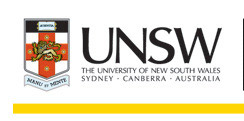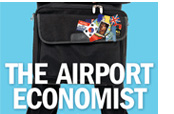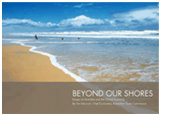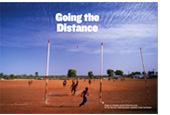Essays on Australia and the Global Economy
By Tim Harcourt, Chief Economist, Australian Trade Commission
I have written a series of essays since 1999 on the amazing events witnessed, and in some cases experienced, and their effect on Australian exporters. The essays have been brought together in this book and arranged by topic – ‘Globalisation and Export Performance’, ‘The Information Age’ and by Australia’s trading regions. And for those, like me, who like the big occasion, there is also a chapter on special events like the Olympic Games, the Rugby World Cup 2003 and the Oscars.
Download a free, PDF version by clicking on the various sections below.
In order to view PDF files on your computer, you must have a PDF reader program installed. You can download a free reader at Adobe’s website.
Read the story behind ‘Beyond Our Shores’ and the OECD book review.
Section 1: Globalisation and Exports
1999 was the year I joined Austrade. More significantly it was also the year of the ‘Battle for Seattle’ – the high water mark of the anti-globalisation protests. In Seattle, thousands of demonstrators converged on the World Trade Organisation (WTO) meetings in protest against ‘globalisation’. The Seattle protests were followed up by similar events – including one in Melbourne on the fateful date of September 11, 2000.
Whilst the protests raised the profile of globalisation as an issue and the WTO as an institution, one problem was a lack of clarity about what ‘globalisation’ actually meant. As a result, I started writing a number of essays explaining globalisation and the role that trade plays in particular. After all, one lesson of the protests is that economics is about persuasion, and it is better to explain than to dismiss or ridicule.
The essays have been the basis for presentations at both ‘pro’ and ‘anti’ globalisation events – namely the Australian chapter of the World Economic Forum based in Davos, Switzerland and the World Social Forum, based in Porto Alegre, Brazil. A main focus is how trade affects the Australian economy in particular in terms of firm performance, the labour market and community welfare as a whole.
Download Section 1: Globalisation and Exports
Section 2: The Information Age
During the latter half of the 1990s, the ‘dot.com’ revolution was all the rage. Newspaper reports were full of terms such as ‘the information age’, the ‘Internet revolution’ and ‘the new economy’ and many commentators claimed that the global economy was being changed in a fundamental way by the Internet, e-commerce and associated technologies. Economists too were grappling with the impact of the new economy with Nobel laureate Robert M. Solow famously saying: “You can see the information revolution everywhere except in the productivity statistics.” Of course, the dot.com ‘crash’ of 2001 brought a lot of the more outlandish claims about the information age to a halt, and analysts looked more carefully at the role that information technology was playing in economic activity and global trade. This chapter focuses on the role of technology in international trade and how Australia fared in the ‘new economy stakes’.
Download Section 2: The Information Age
Section 3: North East Asia
There is no doubt that North East Asia is the place to be for Australian exporters. The region accounts for over a third of Australia’s merchandise exports and over 10,500 exporters. And there’s a fair bit of consensus that Japan, South Korea and China will continue to play an important role in Australia’s export future. However, there was a time when few Australians thought we could be a significant exporter to that part of the world. In fact, it was only when Professor Ross Garnaut of the Australian National University wrote his seminal work “Australia and the North East Asia Ascendancy” in 1989, that many Australian business and policy makers started to take notice of the markets to our north.
This chapter covers the countries of the North East Asia region. It includes the themes of ageing in Japan, IT and creative exports to South Korea, and, of course, the amazing story of China’s rise and rise as an economic power and export destination for Australia.
Download Section 3: North East Asia
Section 4: South Asia, South East Asia and the Pacific
When it comes to trade potential, the neighbourhood you are in is said to make a big difference. This chapter covers Australia’s neighbourhood and our trading relationships with the ASEAN economies in South East Asia, New Zealand, Papua New Guinea, island nations in our immediate neighbourhood in the Pacific, and South Asia as well. The role of India as an economic superpower to rival China is a given a special focus. Asia’s rise means that Australia seems to be ‘at the right place at the right time.’
Download Section 4: South Asia, South East Asia and the Pacific
Section 5: Europe, the Middle East and Africa
The countries of Europe, the Middle East and Africa are a long way from Australia due to our ‘tyranny of distance’, and seem to be so diverse that they share little in common apart from a common time zone. This chapter covers the enlargement of the European Union (to include the former eastern bloc countries), the introduction of the common currency (‘the euro €’), and the export efforts of Australia in the Middle East region in both the Arab League states and with Israel. The chapter also includes an analysis of Australia’s trade relationship with South Africa – 10 years after the election of Nelson Mandela as South Africa’s first President of the post-apartheid era.
Download Section 5: Europe, the Middle East and Africa
Section 6: The Americas
When people think of The Americas they mainly focus on the United States. This has particularly been so with the Australia-United States Free Trade Agreement attracting the lion’s share of press coverage on trade issues generally. However, there is plenty of Australian export action in Latin America too. Accordingly, this chapter includes essays on South America – based on visits to Brazil and Argentina – as well as the countries of Central America.
Download Section 6: The Americas
Section 7: The Economics of Special Events
Who said exporting can’t be fun? Arts, sport and entertainment all have trade dimensions as well, particularly when special events like the Olympics put Australia on the radar screen. This chapter looks at the economics of special events including the Olympic Games, the Rugby World Cup, The Melbourne Cup, the Grand Prix, and, of course, Oscar night when Australia’s most famous and glamorous exports are on display for all the world to see and admire.
Download Section 7: The Economics of Special Events
Cover, Introduction and Further Reading
Download the cover and introduction, and further reading sections.














No Comments so far ↓
Comments are closed.